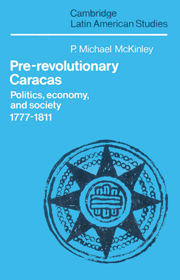Book contents
- Frontmatter
- Contents
- List of Maps
- List of Tables
- Acknowledgements
- Measures and Money
- Glossary
- Introduction
- Part One Society
- 1 The Caste Society
- Part Two Economy
- Part Three Politics
- Epilogue
- Appendix A Geographical distribution of haciendas and hatos in Caracas 1785–1787
- Appendix B Consulado membership
- Notes
- Bibliography
- Bibliographical appendix
- Index
- CAMBRIDGE LATIN AMERICAN STUDIES
1 - The Caste Society
Published online by Cambridge University Press: 30 October 2009
- Frontmatter
- Contents
- List of Maps
- List of Tables
- Acknowledgements
- Measures and Money
- Glossary
- Introduction
- Part One Society
- 1 The Caste Society
- Part Two Economy
- Part Three Politics
- Epilogue
- Appendix A Geographical distribution of haciendas and hatos in Caracas 1785–1787
- Appendix B Consulado membership
- Notes
- Bibliography
- Bibliographical appendix
- Index
- CAMBRIDGE LATIN AMERICAN STUDIES
Summary
The demographics of Caracas
The population of Caracas can be examined with a great degree of accuracy thanks to the extraordinary compilation of data for the colonial Bishopric of Caracas carried out by John Lombardi. By extracting and quantifying the information contained in several hundred parish censuses, he has presented a unique picture of the demographic history of the province in the late eighteenth and early nineteenth centuries using the data available for the decade 1800–9 as the centre-piece of his analysis. Of particular interest are his figures on Caracas' racial composition and the regional, urban and rural distribution of the province's population. If Lombardi's study is compared with the more modest census carried out by José de Castro y Aráoz between 1785 and 1787, some observations can also be made about the growth rate of the population and of specific racial groups in our period.
The province of Caracas had about 455,000 inhabitants in 1810 (Table 1). The racial composition of this population can be broken down into four broad categories: whites, free-coloureds of mixed or black descent (the castas), black slaves and Indians. The overwhelming majority of the castas in Caracas were mixed free-coloureds of part-African ancestry and were commonly known as pardos. The term pardo as it was used in Caracas erased the finer legal distinctions between mulattos, zambos and the like. The castas as a whole were the most numerous racial group in the province, representing just over 45% of the total population. Whites followed with roughly 25% and slaves and Indians with about 15% each.
- Type
- Chapter
- Information
- Pre-Revolutionary CaracasPolitics, Economy, and Society 1777–1811, pp. 9 - 32Publisher: Cambridge University PressPrint publication year: 1986



